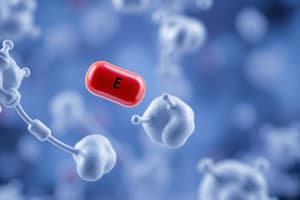Podcast
Questions and Answers
Isoniazid is a drug known to inhibit drug metabolizing enzymes.
Isoniazid is a drug known to inhibit drug metabolizing enzymes.
True (A)
The first pass effect increases the concentration of a drug before it reaches systemic circulation.
The first pass effect increases the concentration of a drug before it reaches systemic circulation.
False (B)
A drug's clearance is defined as the volume of plasma from which the drug is completely removed in unit time.
A drug's clearance is defined as the volume of plasma from which the drug is completely removed in unit time.
True (A)
Mothers who are lactating can safely use sulfonamides without any contraindications.
Mothers who are lactating can safely use sulfonamides without any contraindications.
The half-life of a drug refers to the time required for its plasma concentration to double.
The half-life of a drug refers to the time required for its plasma concentration to double.
Phase-I reactions in biotransformation do not involve chemical alterations of the parent drug.
Phase-I reactions in biotransformation do not involve chemical alterations of the parent drug.
One of the consequences of microsomal enzyme induction is increased duration of action for drugs that are inactivated by metabolism.
One of the consequences of microsomal enzyme induction is increased duration of action for drugs that are inactivated by metabolism.
Autoinduction occurs when a drug enhances its own metabolism, as seen with carbamazepine.
Autoinduction occurs when a drug enhances its own metabolism, as seen with carbamazepine.
Glucuronide conjugation is an example of a synthetic or Phase-II reaction in biotransformation.
Glucuronide conjugation is an example of a synthetic or Phase-II reaction in biotransformation.
Phenobarbitone is used to enhance the clearance of bilirubin in patients with congenital nonhaemolytic jaundice.
Phenobarbitone is used to enhance the clearance of bilirubin in patients with congenital nonhaemolytic jaundice.
Sulfate conjugation is primarily associated with the metabolism of chloramphenicol.
Sulfate conjugation is primarily associated with the metabolism of chloramphenicol.
Acute paracetamol toxicity can occur at lower doses in patients who are taking medications that induce enzymatic activity.
Acute paracetamol toxicity can occur at lower doses in patients who are taking medications that induce enzymatic activity.
The use of enzyme inducers can interfere with the adjustment of oral anticoagulant doses like Warfarin.
The use of enzyme inducers can interfere with the adjustment of oral anticoagulant doses like Warfarin.
Flashcards are hidden until you start studying
Study Notes
Biotransformation (Metabolism)
- Biotransformation is the chemical alteration of a drug in the body.
- Phase I reactions (nonsynthetic) convert a parent drug to a more polar metabolite through oxidation (e.g., barbiturates), reduction (e.g., chloramphenicol), or hydrolysis (e.g., procaine).
- Phase II reactions (synthetic or conjugation) involve coupling the drug or its metabolites with an endogenous substrate (e.g., glucuronic acid, sulfuric acid, acetic acid, amino acid).
- Glucuronide conjugation: e.g., chloramphenicol
- Sulfate conjugation: e.g., steroids
- Glycine conjugation: e.g., aspirin
- Acetylation: e.g., sulfonamides
- Methylation: e.g., histamine
Enzyme Induction
- Enzyme induction is the increased synthesis of drug-metabolizing enzymes, often by drugs themselves.
- Consequences of microsomal enzyme induction:
- Decreased intensity/duration of action: for drugs inactivated by metabolism (e.g., contraceptive failure).
- Increased intensity of action: for drugs activated by metabolism (e.g., acute paracetamol toxicity).
- Tolerance: if a drug induces its own metabolism (autoinduction; e.g., carbamazepine, rifampin).
- Faster metabolism of endogenous substrates: e.g., steroids, bilirubin.
- Intermittent use of an inducer: can interfere with dose adjustments of other drugs (e.g., oral anticoagulants like Warfarin).
Enzyme Inhibition
- Drugs that inhibit drug-metabolizing enzymes:
- Allopurinol
- Omeprazole
- Erythromycin
- Ketoconazole
- Ciprofloxacin
- Isoniazid
First-Pass Effect
- This effect occurs during drug metabolism where the concentration of a drug is significantly reduced before it reaches the systemic circulation.
- Examples of drugs affected by the first-pass effect:
- Phenobarbitone
- Aspirin
- Isoprenaline
- Propranolol
- Lidocaine
- Hydrocortisone
- Salbutamol
Excretion
- Excretion is the passage of a systemically absorbed drug out of the body.
Methods to Prolong Drug Action
- Prolonging absorption from the site of administration
- Increasing plasma protein binding
- Retarding the rate of metabolism
- Retarding renal excretion
Drugs Contraindicated in Lactating Mothers
- Sulfonamides, Tetracycline, Chloramphenicol, Isoniazid
- Morphine, Sedative, Hypnotic Drugs (Diazepam)
- Phenothiazines, Lithium
- Antithyroid drugs, Radioactive Iodine
- Senna and related purgatives, Metronidazole
- Anticancer drugs, Corticosteroids
Clearance
- Clearance is the theoretical volume of plasma from which a drug is completely removed in a unit time.
- Formula: CL = Rate of elimination / Concentration of drug (in blood or plasma)
Half-Life (t ½)
- The time it takes for the plasma concentration or the amount of drug in the body to be reduced by 50%.
Steady State
- Achieved when drug administration equals drug elimination (approximately 5 times the half-life).
Studying That Suits You
Use AI to generate personalized quizzes and flashcards to suit your learning preferences.



